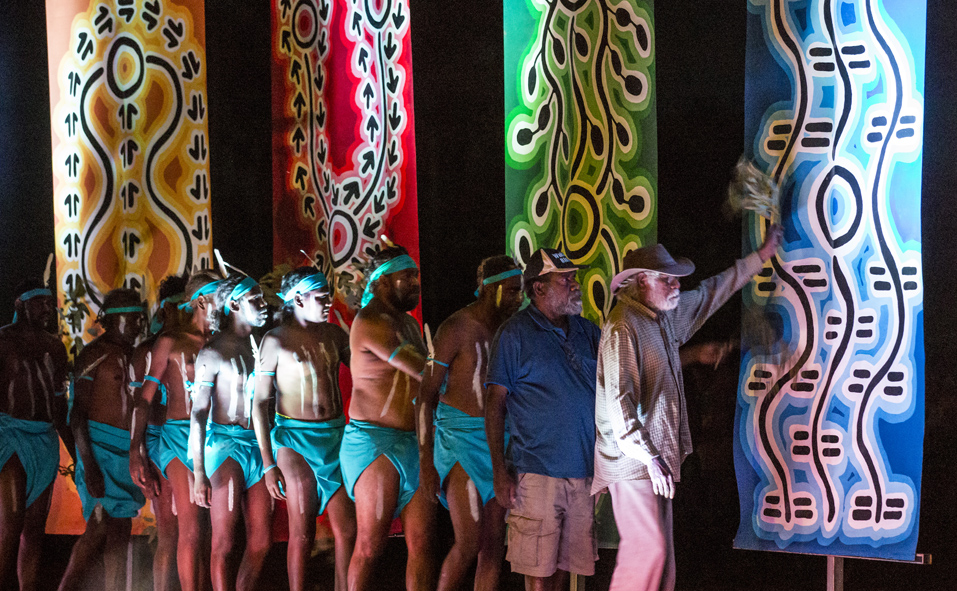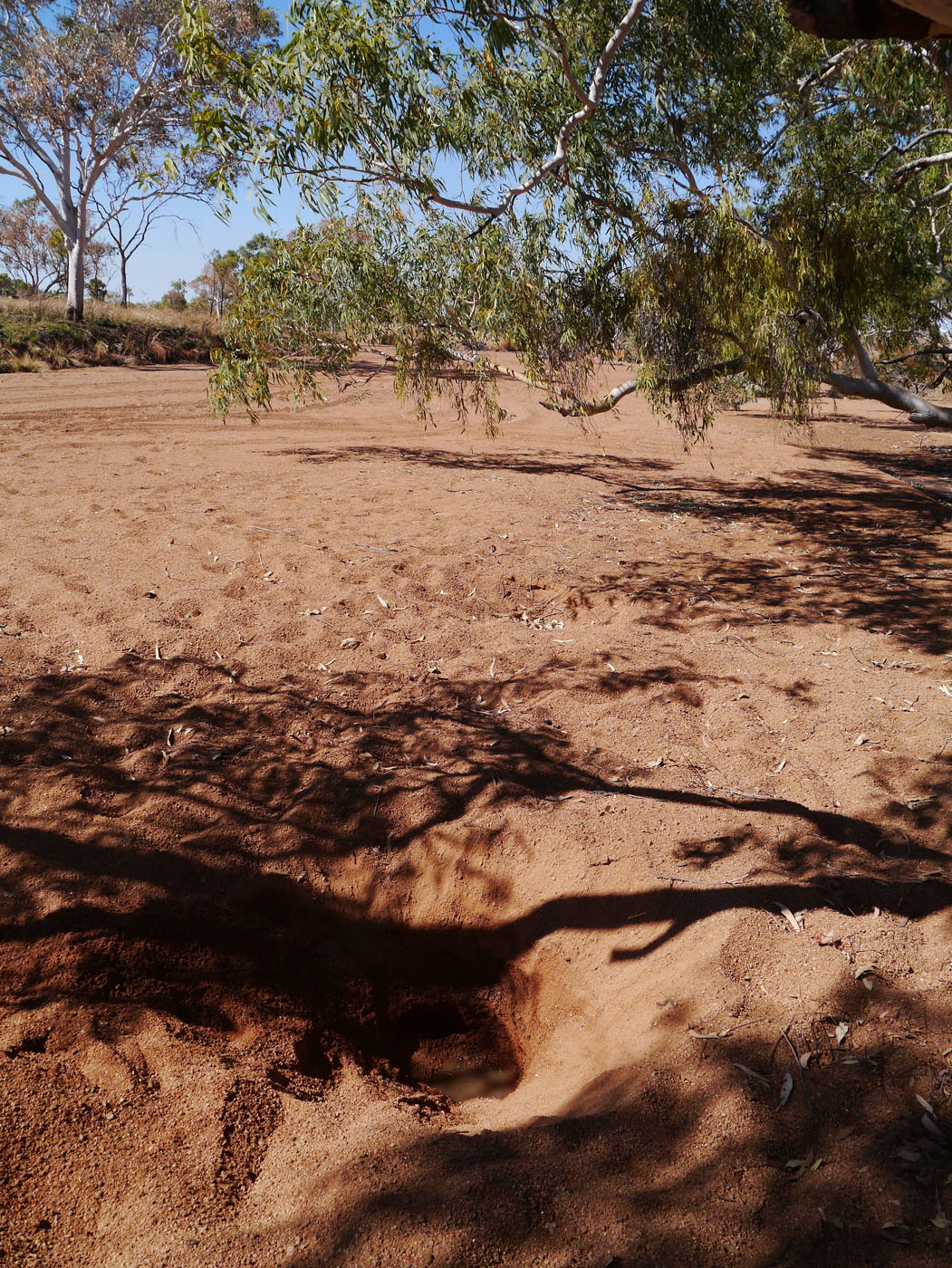Milpirri Banner - MIKANJI NGAPA (Rain at Mikanji)
Dreaming
Mikanji Ngapa (Ngapa is any form of water, or source of water, any place with water – it could be water, rain, humidity, rain-cloud, or any water source). Mikanji is an important place on the Rain Dreaming tracks. This banner is for the Rain Dreaming at Mikanji. ). The short parallel lines are clouds called ‘mangkurdu’ (cumulus & stratocumulus clouds), and the long curving lines are water running into the circles which are the waterholes or soakages (mulju) along the creek at Mikanji.
Belonging to Skin Groups
Jangala, Jampijinpa, Nangala and Nampijinpa (Blue Group)
Place
Lajamanu elders explain that Mikanji is not far from Mt Doreen on the west side. This rain started at Warlaparnpa. It is a different rain dreaming from the Kurlpulrunu rain dreaming and the Pirlinyarnu rain dreaming. At Mikanji Nakamarra/Jakamarra and Naparurla/Jupururla Ngapa (Rain Dreaming) from Karlipinpa were fighting with the Nampijinpa/Jampijinpa & Nangala/Jangala Ngapa (Rain Dreaming).
See and read about Kurlpulrunu from its Milpirri banner page - Photos / Information
See and read about Pirlinyarnu from its Milpirri banner page - Photos / Information
Find Mt Doreen here on this Google satellite map - Map
The country associated with this ‘Ngapa Jukurrpa’ (Water Dreaming) is Mikanji, a watercourse west of Yuendumu that is usually dry. There are ‘mulju’ (soakages) in this creek bed. The ‘kirda’ (owners) of this Dreaming site are Nangala/Nampijinpa women and Jangala/Jampijinpa men. Mikanji is an important water Dreaming site, and features in at least three different water Dreaming tracks. Motifs frequently used to depict this story include concentric circles representing ‘mulju’ (water soakages) and short bars depicting ‘mangkurdu’ (cumulus & stratocumulus clouds).
Map
See the location of the Mikanji spring on the South Tanami IPA. Either click on the "Jukuurpa Yirdiyi Kari-Yardiyi Kari" tab, or change to English and click on the "Jukurrpa map" tab. Look near the road south of Chilla Well - Map
Moral
Wanta Patrick Jampijinpa interprets that the moral of this dreaming is not to disturb the flow of ngapa (water, for example, with activities like fracking.) This part of the story is also about having a clear path, and not coming into another’s territory.
Drawn By
Most likely to have been drawn by Norman Jampijinpa Kelly in 2005.
Artist Profile
Norman Jampijinpa Kelly. A Warlpiri artist and senior man at Mt Liebig (NT) where he occasionally painted for Papunya Tula Artists in the mid-1980s. He primarily painted independently for freelance dealers and, for some time, the Centre for Aboriginal Artists. His work is represented in major public and private collections.
Born 'in the bush’ c.1938 to the north of Mt Liebig and about five miles (8 km) south of present-day Yuendumu, Norman Kelly is one of the senior men of the Mt Liebig community, where he and his wife, Lily Kelly, lived with their family. After years working as a stockman, mustering cattle all across the Centre, Norman began painting occasionally for Papunya Tula Artists in the mid-1980s when the company began to service the artists at Mt Liebig. A Warlpiri speaker, Norman’s country lies around Mt Leibig (Amunturangu), 80 kms west of Papunya and further north. His father’s country lies in Warlpiri territory around Waylilimpa and he paints Bush Potato, Watanuma (Flying Ant), Mulga Tree and other Bush Tucker stories, and Watia Warnu (Women with Digging Stick and Coolamon at Mt Liebig) Dreamings. Norman’s paintings are now usually sold through the Centre for Aboriginal Artists or freelance art dealers. He is the stepson of Paddy Tjangala, and step brother of Sandra Nampitjinpa , Sonder Turner and Petra Nampitjinpa . Of late, his output has slowed, possibly related to problems of distribution experienced in the Mt Liebig community over the past few years. His sister, Diana Marshall Nampitjinpa, also about the same age as Norman, has also painted occasionally – mainly Bushfire and 'Lover Boy’ Dreamings, which she sold through the Centre for Aboriginal Artists in Alice Springs. Norman’s work was shown at the Gauguin Museum, Tahiti in 1988. Collections: Flinders University Art Museum, Holmes à Court, Australian Museum, Sydney.
Writers: Johnson, Vivien Note: Primary biographer. Date written: 1994 Last updated: 2011
Family
Kelly and Gallagher.
Language Stories
Mangkurdu (English: cloud, cumulus, stratocumulus.) (Definition: cloud other than dark rain cloud, capable of building into a rain cloud.)
Mangkurdu karnalu ngarrirni milpirriwangu ngari yangka mawarnamipa kujaka nguna. Kajara, ngula karnalu ngarrirni, yirdipatu - mangkurdu, mawarna, kajaramipa. Milpirriwangu. Kujakarnalu kajaramipa ngarrirni mangkurdumipa, milpirriwangu. Ngulangkaju ka kardu-mani milpirrilki. Milpirrilki ka ngurrju-mani mangkurdurlaju.
We call mangkurdu the one that is not a rain cloud and merely lies there as a cloud. Kajara, that is what we call it. It has three names, mangkurdu, mawarna, and just kajara - not rain clouds. The ones we call kajara, and mangkurdu, the ones that are not rain clouds, it (water) makes them into rain clouds. It forms rain clouds where there are cumulus clouds.
Mulju (English: hole, basin, depression, soak, soakage, well.) (Definition: cavity or depression in the surface of (soft) earth or sand, typically where subterranean water is found.) (Part of speech: N.)
Pangirni karnalu nyanunguju ngulya - muljuju. Yakiri walya karnalu pangirni, ngapalku karnalu parrpardaji palka-manirra.
We dig out a soak - a well. We dig out the wet earth and then we find the water deep down at the bottom.
Pilingki kalarnalu mulju pangurnu.
We used to dig a well with a wooden scoop called pili.
Source: Dictionary Source: Laughren, M., K. L. Hale, and Warlpiri Lexicology Group, 2005 Warlpiri-English Encyclopaedic Dictionary. (Accessed Via Kirrkirr Interface to Electronic Files.) University of Queensland.
Dreaming information from Warlukurlangu arts in Yuendumu
The country associated with this ‘Ngapa Jukurrpa’ (Water Dreaming) is Mikanji, a watercourse west of Yuendumu that is usually dry. There are ‘mulju’ (soakages) in this creek bed. The ‘kirda’ (owners) of this Dreaming site are Nangala/Nampijinpa women and Jangala/Jampijinpa men. Mikanji is an important water Dreaming site, and features in at least three different water Dreaming tracks.
In one story, the Water Dreaming travelled from Puyurru, northwest of Yuendumu, to a ‘mulju’ (soakage) in the Mikanji creek. It unleashed a huge storm there. Two old blind women of the Nampijinpa skin group were sitting by the side of the soakages. As the two women strained their eyes to see the sky, tears formed in their eyes, creating the rain. Their spirits can still be seen at Mikanji in the form of two ‘ngapiri’ (river red gums) growing near the soakage.
A second water Dreaming track that passes through Mikanji is also owned by the Nangala/Jangala and Nampijinpa/Jampijinpa subsections and travels further west. At Mikanji, the storm rained so hard it created a hole in the ground which became a soakage. At Mirawarri a ‘kirrkarlanji’ (brown falcon [Falco berigora]) picked up the storm and carried it on its wings to the west until it became too heavy for it. The falcon eventually dropped the storm at Pirlinyarnu (Mt. Farewell) about 165 km west of Yuendumu, where it formed an enormous ‘maluri’ (claypan). A ‘mulju’ (soakage) exists in this place today.
A third Dreaming track that passes through Mikanji is the story of the water Dreaming and ‘pamapardu Jukurrpa’ (termite Dreaming). This Dreaming travels further north. This water Dreaming is owned by Nakamarra/Napurrurla women and Jakamarra/Jupurrurla men. The termite and water Dreamings travelled together from Warntungurru in the east past Warlura (a waterhole 8 miles east of Yuendumu), Wirnpa, Kanaralji, Ngamangama, and Jukajuka. A portion of this Dreaming track also includes the ‘kurdukurdu mangkurdu Jukurrpa’ (children of the clouds Dreaming). The termite Dreaming moved on to the west to Nyirrpi, a community approximately 160 km west of Yuendumu, whereas the water Dreaming travelled on to Mikanji. A ‘kirrkarlanji’ (brown falcon) eventually picked up the water and tied it to its head using hairstring. The falcon travelled north with the water Dreaming; at Puyurru, it flew under a tree and the water fell off of its head, forming a soakage there. The Dreaming then travelled on through other locations including Yalyarilalku, Mikilyparnta, Katalpi, Lungkardajarra, Jirawarnpa, Kamira, Yurrunjuku, and Jikaya before moving on into Gurindji country to the north.
In contemporary Warlpiri paintings, traditional iconography is used to represent the ‘Jukurrpa’ (Dreaming), associated sites, and other elements. In many paintings of this Dreaming, short dashes are often used to represent ‘mangkurdu’ (cumulus & stratocumulus clouds), and longer, flowing lines represent ‘ngawarra’ (flood waters). Small circles are used to depict ‘mulju’ (soakages) and river beds.
![The short parallel lines on this Ngapa banner are clouds called ‘mangkurdu’ (cumulus & stratocumulus clouds). Cumulous clouds over the desert: By La Citta Vita (Clouds over the desert - Uploaded by Albert Herring) [CC BY-SA 2.0 (https://creativecommons.org/licenses/by-sa/2.0)], via Wikimedia Commons.](/sites/default/files/banners/photos/Clouds_over_the_desert_%286043195804%29-min.jpg)



